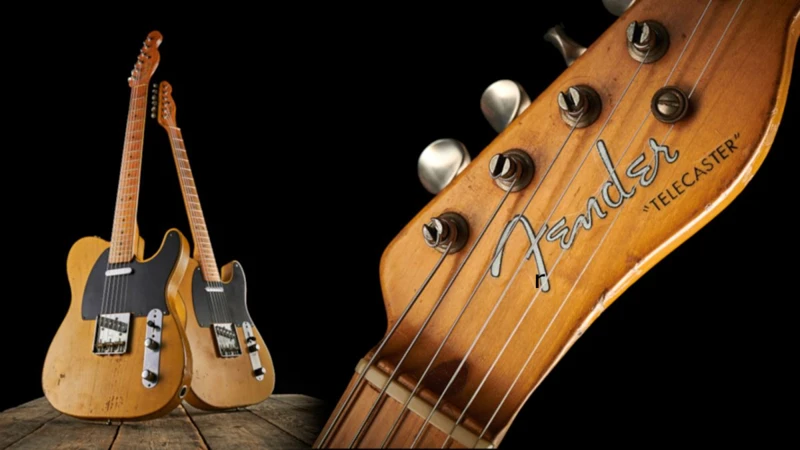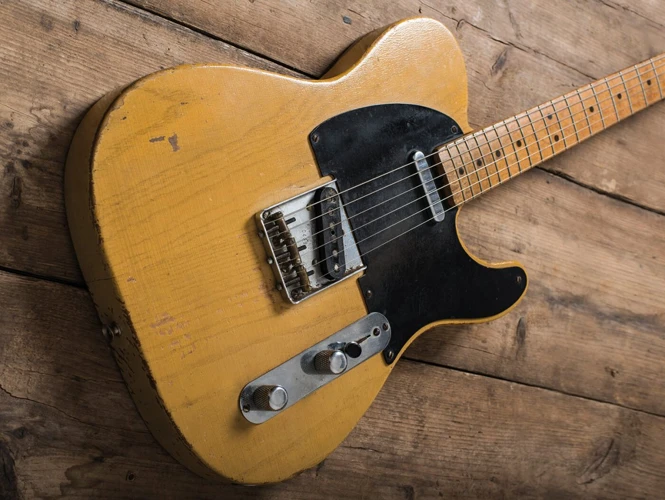The Telecaster, Fender’s first production solid-body electric guitar, has a long and storied history. From its introduction in 1951 to the present day, the Tele has been a workhorse instrument for musicians in a wide variety of genres, from country and rock to pop and blues. But it was in country music where the Telecaster really came into its own, becoming an iconic instrument of the genre and helping to define the sound of country music for generations of musicians and fans. In this article, we’ll explore the history of the Telecaster in country music, and examine how the “gritty” sound of this classic guitar helped to revolutionize the genre.
The Early Days of the Telecaster in Country Music
The Telecaster was first introduced in 1951, and it wasn’t long before country musicians began to take notice. With its bright, twangy sound and solid construction, the Tele was the perfect instrument for the rough-and-tumble world of country music. Early adopters of the Telecaster in country music included artists like Jimmy Bryant, who was one of the first to record with the instrument, and Grady Martin, who used a Telecaster to record the famous guitar riff on Marty Robbins’ hit “Don’t Worry ‘Bout Me.”
The Telecaster and the “Nashville Sound”
In the 1950s and 1960s, the Telecaster became an essential part of the “Nashville Sound,” a style of country music that was characterized by its smooth, polished production values. The Tele’s bright, cutting tone was the perfect counterpoint to the lush string arrangements and background vocals that were a hallmark of the Nashville Sound. Artists like Chet Atkins, who was one of the most influential guitarists in the history of country music, and Roy Clark, who became a household name as a co-host of the TV show “Hee Haw,” helped to popularize the Telecaster as a country instrument during this period.
The Telecaster and Outlaw Country
In the 1970s, a new breed of country musicians emerged who were dissatisfied with the slick, over-produced sound of the Nashville Sound. These artists, who became known as the “outlaws,” sought to return to the raw, unvarnished sound of classic country music. And once again, the Telecaster was there to lead the way. Artists like Waylon Jennings, Willie Nelson, and Kris Kristofferson all used Telecasters to create the gritty, stripped-down sound that defined the outlaw movement.
The Telecaster and Modern Country
Today, the Telecaster remains a staple of country music, both on stage and in the studio. Artists like Brad Paisley, Keith Urban, and Vince Gill all use Telecasters to create their unique sound, and the instrument is a common sight at country music festivals and concerts around the world. The Telecaster’s bright, twangy sound has become synonymous with country music, and it’s hard to imagine the genre without this classic instrument.
The Gritty Sound of the Telecaster
So what is it about the Telecaster that has made it such an essential part of country music? One reason is the instrument’s unique sound. With its single-coil pickups and solid body, the Telecaster has a bright, twangy tone that is perfect for country music. But the Telecaster is also capable of producing a wide range of sounds, from warm, mellow tones to gritty, distorted tones that can cut through even the densest mix. This versatility has made the Telecaster a favorite of country musicians for decades.
The Telecaster and Country Music Culture
Another reason for the Telecaster’s enduring popularity in country music is its cultural significance. The Telecaster is a symbol of the working-class roots of country music, and its rugged, no-nonsense design reflects the values of hard work, authenticity, and simplicity that are at the heart of the genre. For country musicians, the Telecaster is more than just an instrument – it’s a way of life.
The Telecaster and Country Music Innovation
Finally, the Telecaster has played a key role in the innovation of country music. With its versatile sound and solid construction, the Telecaster has inspired countless musicians to push the boundaries of the genre, from the smooth, polished sounds of the Nashville Sound to the raw, unvarnished sound of outlaw country. And even today, the Telecaster continues to be a source of inspiration for country musicians who are looking to create something new and different.
Interested in learning more about the history of country music and its iconic instruments? Check out our articles on how the classic country strumming style evolved, the impact of the Les Paul on the genre, and how the electric guitar transformed country music. Dive deeper into the roots of country music with a look at the history of flatpicking in country music!
Conclusion
In conclusion, the Telecaster has had a profound impact on country music, helping to define the sound of the genre and inspiring generations of musicians to create their own unique music. From its early days as a favorite of country pioneers like Jimmy Bryant and Grady Martin, to its role in the creation of the Nashville Sound and the outlaw movement, the Telecaster has been an essential part of country music’s rich history. And with its versatile sound and rugged design, the Telecaster is sure to continue to be a favorite of country musicians for years to come.



